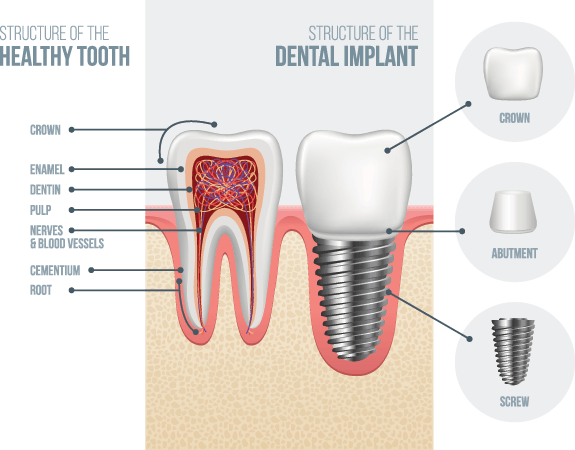
DENTAL IMPLANTS
What Are Implants?
Dental implants are a prosthetic and artificial way to replace a lost or missing tooth.
The implant or screw-like part is embedded in your jawbone. The tooth part or crown is connected either by an internal screw or cement.
Typically, implants are done in 2 stages: a surgical/placement stage and a crown stage. After placement, we allow at least 3-6 months of bone and gum healing before we place the final crown on top.
Why Choose Implants?
Implants have been shown to be a reliable long-term solution to replace missing teeth and function like natural teeth. This means that they allow you to eat and speak normally, and they also help to preserve the integrity of your jawbone and surrounding teeth
In addition to these functional benefits, dental implants can also improve the appearance of your smile. They are designed to look and feel like natural teeth, so you can feel confident about your appearance when you have dental implants.
You may consider tooth replacement because you want to restore your smile or be able to chew the foods you love comfortably. Consider it an investment for optimal health and well-being.
How We Can Help You
At our clinic, we are able to do both stages of the implant treatment.
We would discuss all tooth replacement options to determine if dental implants are the best choice for you.
We would spend some time gathering the necessary records (molds, x-rays, photos). We will also let you know if bone grafting is needed to improve the foundation and long term prognosis.
In general, good candidates for dental implants are in good overall health and have sufficient bone density in their jaw to support the implant. We will help you determine if dental implants are the right option for you.

Implant vs Bridge,
What is the Best Option for You?
Missing teeth as a result of cavities, gum disease, or other various reasons is commonplace. Replacement of these missing teeth can help restore your amazing smile and improve your chewing ability. For a single missing tooth, an implant or a bridge can achieve these goals. Depending on your situation, one option may be better than another.
Implant | Bridge | |
|---|---|---|
Fixed / Removable | Fixed | Fixed |
Cost | $$$$ | $$$ |
Treatment Time | Long, months to a year | Short, within a month |
Surgery | Invasive, drilling into bone | Less invasive, confined to teeth |
Neighbouring Teeth | Untouched | Cut down to accommodate crown |
Oral Hygiene | Floss normally | Need special floss to thread underneath |
Success Rate | High | High |
Can It Fail Over Time? | Yes | Yes |
Implant
Pros: It is the most tooth-like prosthetic option and is fixed into bone. The neighbouring teeth are not drilled and flossing is normal.
Cons: It is the most expensive option and it takes many months to complete. Oral surgery is required by drilling into bone and additional procedures may be needed such as bone grafting, gum grafting, or sinus lifting to improve the implant foundation. Insurance coverage is limited.
Risks: implant/crown fracture, screw loosening, bone doesn’t heal well around implant, gum disease around implant
Bridge
Pros: it is best when the neighbouring teeth have existing fillings and crowns will serve well long-term. Treatment time is shorter and should not require surgery.
Cons: The neighbouring teeth require drilling to create space for the crown material. This drilling can cause tooth nerve damage, requiring root canal treatment. Flossing is more difficult underneath the bridge. Insurance coverage is also limited.
Risks: crown and tooth fracture, cavities can form under the bridge, gum disease, failure of one abutment tooth will create a larger space.

Denture
Pros: It is the most cost-effective method to replace multiple missing teeth. It usually doesn't require surgery and treatment time is relatively quick. Teeth that are lost in the future can be added onto the existing appliance.
Cons: It is removable and requires adaptation to get used to wearing. As an appliance, it can seem bulky initially. Adjustments will be needed to maintain the fit and retention.
Risks: jaw bones and gums can change over time, meaning the denture will not fit as well and need adjustments to fit again. Dentures can break from normal use

Maryland Bridge
A lesser-known option that can be used to replace mainly front teeth. The replacement tooth is bonded to the neighbouring teeth. It can be bonded either to the back side of the teeth or via an orthodontic wire retainer.
Pros: It is a fixed option that is less invasive compared to a bridge.
Cons: It is limited to front teeth only where the bite is allowable for this to not break off from normal use. Flossing is similar to a bridge
Risks: can debond or fracture, gum can recede underneath and create a gap
